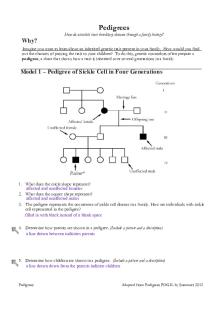Pedigree Analysis worksheet 1 PDF

| Title | Pedigree Analysis worksheet 1 |
|---|---|
| Course | Human Genes and Precision Medicine |
| Institution | University of Technology Sydney |
| Pages | 6 |
| File Size | 274.6 KB |
| File Type | |
| Total Downloads | 67 |
| Total Views | 176 |
Summary
Pedigree Analysis worksheet 1...
Description
91148 Human Genetics and Precision Medicine Pedigree Analysis Worksheet Question 1 You will practice interpreting a pedigree. The pedigree below shows the presence or absence of the albinism trait in several generations of a family.
Analysis 1. Determine whether the albinism trait is dominant or recessive. Explain your reasoning.
2. Determine the genotypes for females A & B.
91148 – Human Genetics and Precision Medicine
Pedigree Analysis Worksheet
3. Based upon your conclusion to Question 1 & 2, determine what the genotype is for the parents of Female A and Female B.
4. Determine the genotypes as many of the family members of this pedigree as possible and label each genotype in the pedigree above. Use the following designations in and place the numbers of each on the lines below:
AA = Homozygous dominant. ________________________________ Aa = Heterozygous: ________________________________ aa = Homozygous recessive: ________________________________ ?? = Not enough information to conclude: ________________________________
5. Suppose that Female C is homozygous dominant and produces children with hypothetical Male D. If Male D is heterozygous, what is the % chance that the children will have the albinism trait? What is the % chance that a child will be a carrier? Complete a Punnet square to show your work.
91148 – Human Genetics and Precision Medicine
Pedigree Analysis Worksheet
6. How does the Punnet square apply to the offspring? For example, if one child matches the genotype of the upper left quadrant of the Punnet square, can the child’s sibling (brother or sister) be the same genotype for the trait or does the Punnet square imply that once the genotype is taken, no other siblings can have that genotype. (See siblings K, L, M, & N). Explain.
7. Name 2 things that a Pedigree can show you.
91148 – Human Genetics and Precision Medicine
Pedigree Analysis Worksheet
Question 2
In the above pedigree, the affected individuals are shown shaded. None of the marriage partners from outside these two families are heterozygous for the trait. 1. How is this particular trait inherited?
2. How many offspring are shown in the second generation?
3. If individual #10 mated with individual # 11, what are the chances of them producing an offspring who is affected?
4. Indicate the genotypes of individuals # 1-10. (Allow the dominant trait to be “A” and the recessive trait to be “a” – NOTE: Some may have two possible genotypes)
91148 – Human Genetics and Precision Medicine
Pedigree Analysis Worksheet
Question 3 The following pedigree represents the inheritance pattern for the sex-linked, recessive trait colour-blindness in humans. The person making this pedigree did NOT identify the carriers of the trait, just those with or without colour blindness. You have to identify the genotypes of all individuals, by writing the genotype clearly above the number. To do this you will use the allele symbols XB for normal colour vision and Xb for the colour-blindness. You must also use the appropriate symbols for the genders. Fill in the genotypes of each of the 23 individuals shown. If the complete genotype cannot be determined from the data provided then the symbol X must be used for the unknown allele.
91148 – Human Genetics and Precision Medicine
Pedigree Analysis Worksheet
Question 4
Possible Inheritance patterns: Autosomal recessive, Autosomal dominant, X-linked recessive, X-linked dominant, Y-linked 1. For each of the pedigrees above, indicate which of the 5 inheritance patterns are possible (there may be more than one possible). Explain your reasoning in each case.
2. Give the genotype for each of the affected individuals in pedigree C.
91148 – Human Genetics and Precision Medicine
Pedigree Analysis Worksheet...
Similar Free PDFs

Pedigree Analysis worksheet 1
- 6 Pages

Pedigree analysis worksheet
- 1 Pages

Pedigree worksheet answers
- 2 Pages

Pedigree Chart Worksheet
- 1 Pages

Pedigree worksheet Answer KEY
- 1 Pages

Literary Analysis Worksheet 1
- 2 Pages

pedigree pogil activity real 1
- 7 Pages

Pedigree Trait identification
- 3 Pages

Visual Analysis Worksheet 2
- 2 Pages
Popular Institutions
- Tinajero National High School - Annex
- Politeknik Caltex Riau
- Yokohama City University
- SGT University
- University of Al-Qadisiyah
- Divine Word College of Vigan
- Techniek College Rotterdam
- Universidade de Santiago
- Universiti Teknologi MARA Cawangan Johor Kampus Pasir Gudang
- Poltekkes Kemenkes Yogyakarta
- Baguio City National High School
- Colegio san marcos
- preparatoria uno
- Centro de Bachillerato Tecnológico Industrial y de Servicios No. 107
- Dalian Maritime University
- Quang Trung Secondary School
- Colegio Tecnológico en Informática
- Corporación Regional de Educación Superior
- Grupo CEDVA
- Dar Al Uloom University
- Centro de Estudios Preuniversitarios de la Universidad Nacional de Ingeniería
- 上智大学
- Aakash International School, Nuna Majara
- San Felipe Neri Catholic School
- Kang Chiao International School - New Taipei City
- Misamis Occidental National High School
- Institución Educativa Escuela Normal Juan Ladrilleros
- Kolehiyo ng Pantukan
- Batanes State College
- Instituto Continental
- Sekolah Menengah Kejuruan Kesehatan Kaltara (Tarakan)
- Colegio de La Inmaculada Concepcion - Cebu






